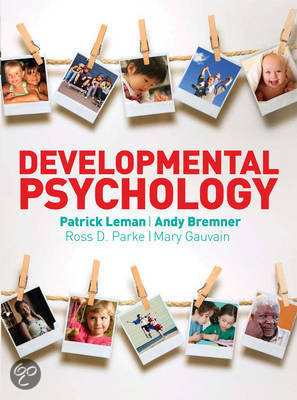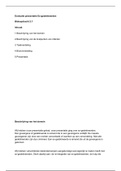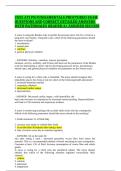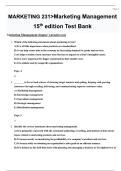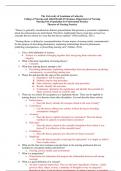Development task 5
What are emotions?
o Emotion is a subjective feeling that is a reaction to the environment; can be
pleasant or unpleasant; accompanies physiological arousal; communication
with others.
o Types of emotions:
Primary emotions (joy, sadness, fear, surprise, disgust and interest) –
no self-reflection.
Secondary emotions (embarrassment, empathy, pride, shame, guilt,
jealousy) – component of self-reflection.
How do children develop emotions?
o Primary emotions develop during first 6 months.
Excitement
Distress Smiling and Laughs Fear, anger
boredom
Positive emotions start with reflex smiles - spontaneous smile seen in
newborn infants that depends on internal state rather than on something
external.
3 – 8 weeks: smiling to external stimuli. Specifically, they like
faces: at first, they look only at the eyes (4 weeks old) and then
gradually the whole face (8 weeks old).
3 months old babies smile to familiar faces. Joy and interest
emerge.
4 months old babies start to laugh. Babies between 4 and 12
months of age increasingly like visual, tactile and social events,
but reaction to auditory stimulation remains the same.
However, social and tactile stimuli are less effective starting
from 7 months of age, but visual stimuli are increasing.
Towards end of first year babies respond more to social games
in which they can participate themselves. For second year
babies laugh and smile even more to activities that they create
themselves. As children grow laughing increases and becomes
more of a social event.
Negative emotions start with disgust - (to bitter tastes- they express
this by spitting out food that is unpleasant) and distress that are not
related to external events.
2,5 - 3 months old babies’ express sadness – especially, when
mothers withdraw their attention.
, Between 4- and 6-months anger appears. Mostly emerges
when children are frustrated.
During first 6 months surprise develops.
Lastly for 7 to 9 months old babies fear develops - immediate
negative reaction to event that has fearful meaning to them.
Fear of strangers - at the age of 4 months they are not yet
distressed to novel people; in fact, they show great interest in
them. Reaches its peak at 18 months. Fearfulness indicates that
child is able to compare stimulus and understand what is
familiar and what is not.
Separation protest (separation anxiety) - infant’s distress
reaction to being separated from his or her mother. This is
universal fear in all cultures and reaches its peak at 15 months
of age. It becomes less and less common in childhood, although
can reappear in different forms.
o Secondary emotions develop from 1,5 until 3 years of age. Before
development of secondary emotions, self-consciousness must develop (starts
at 1,5 years of age) - cognition related to self. Before consciousness emerges
children express emotions as states (no understanding of emotions).
Understanding of emotional experiences require that the child knows about
this state as saying: “I am happy”. Awareness of state becomes experience.
At 2 years of age develops embarrassment (non-evaluative), envy
(jealousy) and empathy. Non-evaluative embarrassment is not related
to negative self-evaluation (also called exposure embarrassment – like
when someone gives compliment or looks at you). These emotions
require self-consciousness, but don’t require ability to evaluate
behaviour against norms.
At 3 years of age develops embarrassment (evaluative), pride,
shame, guilt. These emotions require development of cognitive skills
– self-evaluation.
Self-evaluation- to develop secondary emotions children must
be aware of some standards, rules and goals. They have to be
able to evaluate the self with regard to those standards, rules
and goals and then make determination of success or failure.
In self-evaluation child has to decide if a particular event is the
result of their own action. If something breaks, they will make
internal attribution (I broke something) or external
attribution (the things was just faulty). This is important
because the same standards and rules can result in radically
different emotions (if they attribute internally or externally).
Finally, children determines if his success or failure is global or
specific. Global (I am bad in general- focus on self) and
specific (what I did specifically then was wrong- focus on
behaviour).
Shame results when a child judges her actions as failure in
regard to her standards, rules and goals and then makes a global
attribution. Child experiencing shame wants to hide or
disappear. Shame is not produced by a specific situation but
rather individual’s interpretation of an event.
2
What are emotions?
o Emotion is a subjective feeling that is a reaction to the environment; can be
pleasant or unpleasant; accompanies physiological arousal; communication
with others.
o Types of emotions:
Primary emotions (joy, sadness, fear, surprise, disgust and interest) –
no self-reflection.
Secondary emotions (embarrassment, empathy, pride, shame, guilt,
jealousy) – component of self-reflection.
How do children develop emotions?
o Primary emotions develop during first 6 months.
Excitement
Distress Smiling and Laughs Fear, anger
boredom
Positive emotions start with reflex smiles - spontaneous smile seen in
newborn infants that depends on internal state rather than on something
external.
3 – 8 weeks: smiling to external stimuli. Specifically, they like
faces: at first, they look only at the eyes (4 weeks old) and then
gradually the whole face (8 weeks old).
3 months old babies smile to familiar faces. Joy and interest
emerge.
4 months old babies start to laugh. Babies between 4 and 12
months of age increasingly like visual, tactile and social events,
but reaction to auditory stimulation remains the same.
However, social and tactile stimuli are less effective starting
from 7 months of age, but visual stimuli are increasing.
Towards end of first year babies respond more to social games
in which they can participate themselves. For second year
babies laugh and smile even more to activities that they create
themselves. As children grow laughing increases and becomes
more of a social event.
Negative emotions start with disgust - (to bitter tastes- they express
this by spitting out food that is unpleasant) and distress that are not
related to external events.
2,5 - 3 months old babies’ express sadness – especially, when
mothers withdraw their attention.
, Between 4- and 6-months anger appears. Mostly emerges
when children are frustrated.
During first 6 months surprise develops.
Lastly for 7 to 9 months old babies fear develops - immediate
negative reaction to event that has fearful meaning to them.
Fear of strangers - at the age of 4 months they are not yet
distressed to novel people; in fact, they show great interest in
them. Reaches its peak at 18 months. Fearfulness indicates that
child is able to compare stimulus and understand what is
familiar and what is not.
Separation protest (separation anxiety) - infant’s distress
reaction to being separated from his or her mother. This is
universal fear in all cultures and reaches its peak at 15 months
of age. It becomes less and less common in childhood, although
can reappear in different forms.
o Secondary emotions develop from 1,5 until 3 years of age. Before
development of secondary emotions, self-consciousness must develop (starts
at 1,5 years of age) - cognition related to self. Before consciousness emerges
children express emotions as states (no understanding of emotions).
Understanding of emotional experiences require that the child knows about
this state as saying: “I am happy”. Awareness of state becomes experience.
At 2 years of age develops embarrassment (non-evaluative), envy
(jealousy) and empathy. Non-evaluative embarrassment is not related
to negative self-evaluation (also called exposure embarrassment – like
when someone gives compliment or looks at you). These emotions
require self-consciousness, but don’t require ability to evaluate
behaviour against norms.
At 3 years of age develops embarrassment (evaluative), pride,
shame, guilt. These emotions require development of cognitive skills
– self-evaluation.
Self-evaluation- to develop secondary emotions children must
be aware of some standards, rules and goals. They have to be
able to evaluate the self with regard to those standards, rules
and goals and then make determination of success or failure.
In self-evaluation child has to decide if a particular event is the
result of their own action. If something breaks, they will make
internal attribution (I broke something) or external
attribution (the things was just faulty). This is important
because the same standards and rules can result in radically
different emotions (if they attribute internally or externally).
Finally, children determines if his success or failure is global or
specific. Global (I am bad in general- focus on self) and
specific (what I did specifically then was wrong- focus on
behaviour).
Shame results when a child judges her actions as failure in
regard to her standards, rules and goals and then makes a global
attribution. Child experiencing shame wants to hide or
disappear. Shame is not produced by a specific situation but
rather individual’s interpretation of an event.
2

